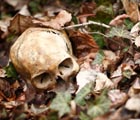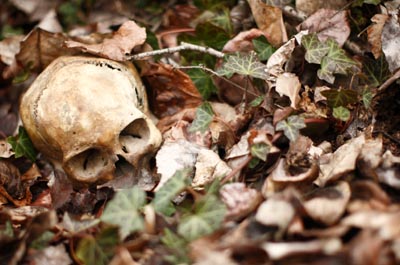Britain’s bloodiest places
What is it about the British countryside that makes it so attractive as a setting for writers of detective fiction?


It is my belief, Watson, founded upon my experience,' muses Sherlock Holmes, observing a few far-flung cottages in The Adventure of the Copper Beeches, ‘that the lowest and vilest alleys in London do not present a more dreadful record of sin than does the smiling and beautiful countryside.' Watson is flabbergasted, but the terrain trod by Holmes and his 20th-century successors Miss Marple, Lord Peter Wimsey, Father Brown, Ruth Rendell's Sussex-based Inspector Wexford and P. D. James's poetry-writing Adam Dalgliesh (to name but a few) is littered with corpses.
And thankfully so, as the distinct rural locales and the characters they encounter in them have left us not only an indelible image of the country life in its heyday, but also the rare poetry of mystery writing. It is what Alexander Pope might have called ‘the evil genius of the place'.
For Holmes, the countryside appears as little more than a logistical problem. Remote settlements are merely opportunities for a crime to go unnoticed, and it's no surprise that his most famous countryside case, The Hound of the Baskervilles, is set on the isolated expanses of Dartmoor. Sir Arthur Conan Doyle, who completed The Lost World only a decade later in 1912, doesn't miss the chance to hurl his urban detective out of the Victorian metropolis and into a primordial atmosphere: rare bitterns fly over Neolithic huts, orchids bloom in the moor crags, wild ponies are sucked into the mire. It's just the sort of place to expect (and accept) a gargantuan hellhound.

If Conan Doyle imagines a detective's landscape, then Agatha Christie peoples it. ‘There is a great deal of wickedness in village life,' Miss Marple is known to repeat, echoing Holmes but meaning something entirely different by it. In the first Marple novel, Murder at the Vicarage, the village of St Mary Mead is a vague, south-eastern Arcadia, where the manor house is called Old Hall and a murder suspect can credibly be named Mrs Lestrange.
It is also a test tube for the study of rural personalities-the misanthropic landlord, the frustrated vicar and his pretty, selfish wife-in which Miss Marple can distill worldliness, that elusive quality that multiplies, perplexingly, in a vacuum.
The wickedness in St Mary Mead is not reflected in the landscape, nor is it caused by a specific state of affairs (a nation between two World Wars or the decline in agriculture). Instead, it is presented as something universal within the human psyche.
Of all pieces of detective fiction, Dorothy L. Sayers's Lord Peter Wimsey mysteries record the most specific image of rural life. In the foreword to Five Red Herrings, set around Kirkcudbright and Gatehouse, Sayers explains that all the places and even the trains mentioned in the Scottish story are real. Although it's set in the imagined Fenchurch St Paul, in The Nine Tailors, she offers a whole history of the village, down to the architecture of its church and the casting of each bell. It could be a snapshot of any Fenland village in the mid 1930s, when inhabitants were adjusting to a post-First World War economy and beginning to buy canned food instead of growing their own.
Exquisite houses, the beauty of Nature, and how to get the most from your life, straight to your inbox.
These villagers do not stand for universal types, but are distinct personages, especially for Sayers, who grew up in an East Anglian rectory. ‘Dig up one thing and you got to dig up another,' a jaunty sluice-keeper tells Lord Peter, with infinite, earthy wisdom. What holds true for dykes, it turns out, also holds for crime: in the village churchyard, a mutilated corpse has been found in an occupied grave. There may have been a murder, but the sluice-keeper has irrigation on his mind.
That classic detective fiction and the country-side are closely linked, even today, has little to do with crime per se. Perhaps if readers gave another glance to those stories (forgetting the murderer and the corpse for a moment), a few pertinent truths might emerge. Countless wickednesses are being inflicted on the countryside, and because of the same blind, urban-centred eyes that Sherlock Holmes condemned more than a century ago.
But, even in crime fiction, the case for the countryside isn't quite so bleak; in the midst of Father Brown pursuing a villain, G. K. Chesterton pauses, breathing optimistic brilliance into his story. ‘The most incredible thing about miracles is that they happen,' the narrator says in The Blue Cross. ‘A few clouds in heaven do come together into the staring shape of one human eye. A tree does stand up in the landscape of a doubtful journey in the exact and elaborate shape of a note of interrogation.'
To the writer of good detective fiction as well as the observer of nature (as every good countryperson is), such manifestations are more common than others might believe. ‘In short,' as Chesterton goes on to say, ‘there is in life an element of elfin coincidence which people reckoning on the prosaic may perpetually miss.'
Britain's bloodiest places West Country The well-heeled holidaymakers that flocked to the Cornish Riviera during detective fiction's golden age brought their grudges with them-sometimes to deadly effect. Miss Marple and Hercule Poirot are forever being summoned to places that bear more than a passing resemblance to their Torquay-dwelling creator Agatha Christie's local area. Elizabeth George's Inspector Lynley has also found a few bodies on the Cornish cliffs and the hit ITV series Broadchurch was set on Dorset's Jurassic coast.
East Anglia The mists that roll in across the Fens are terrifically creepy-and the perfect cloak for a murderer. Modern-day Philip Marlowe Jackson Brodie walks the cobbles of Cambridge in Kate Atkinson's Case Histories and Suffolk regularly serves as a spine-chilling backdrop for P. D. James and Margery Allingham. Yorkshire Ever since Dracula washed up in Whitby, Yorkshire has had a reputation for sinister (fictional) goings-on. Lord Peter Wimsey journeyed northwards to solve a mysterious shooting in the Dales in Clouds of Witness and Peter Robinson's salt-of-the-earth Inspector Alan Banks continues to find bloody footprints all over the Dales.
* Follow Country Life on Twitter
Emma Hughes lives in London and has spent the past 15 years writing for publications including the Guardian, the Telegraph, the Evening Standard, Waitrose Food, British Vogue and Condé Nast Traveller. Currently Country Life's Acting Assistant Features Editor and its London Life restaurant columnist, if she isn't tapping away at a keyboard she's probably taking something out of the oven (or eating it).
